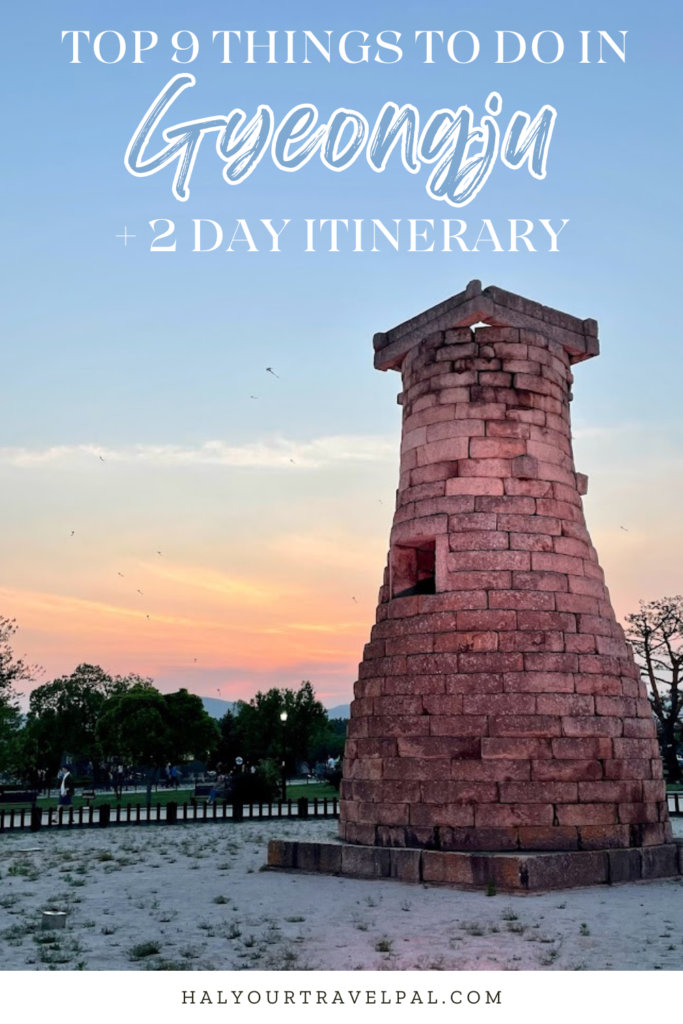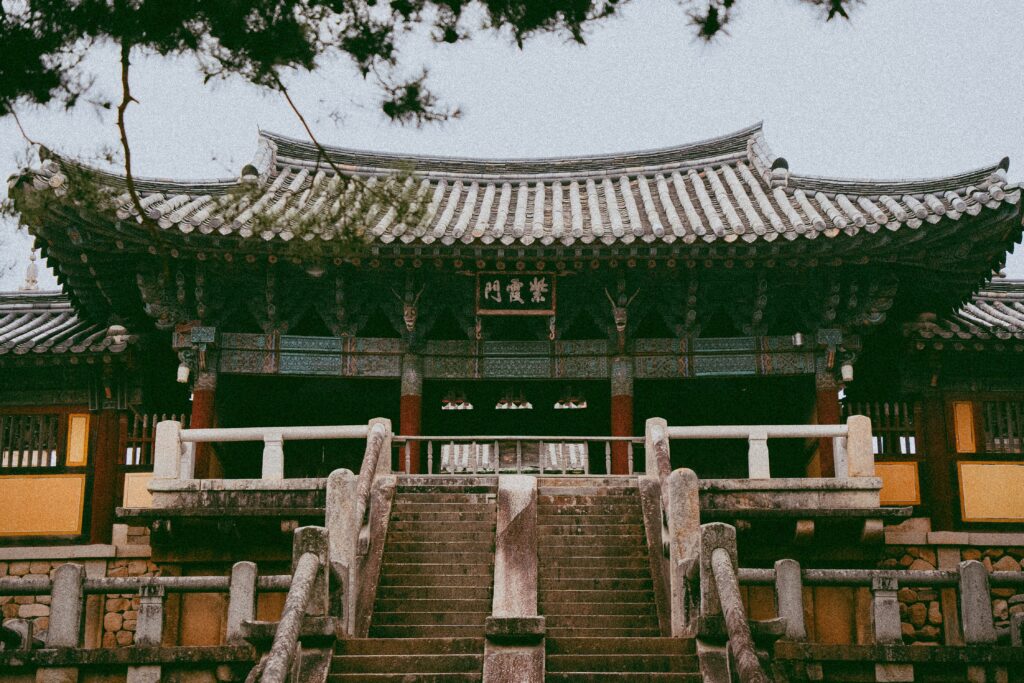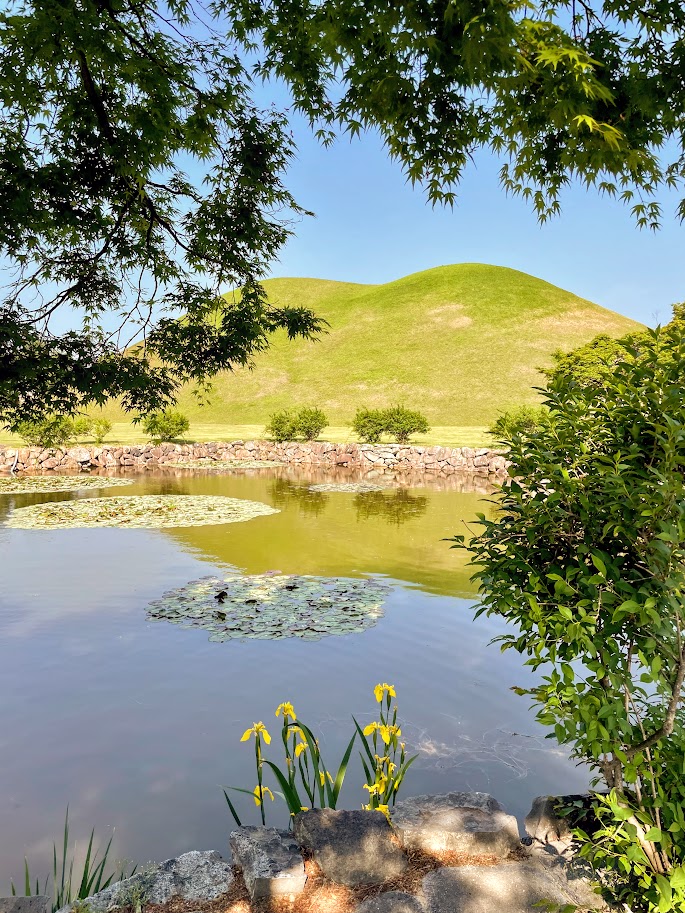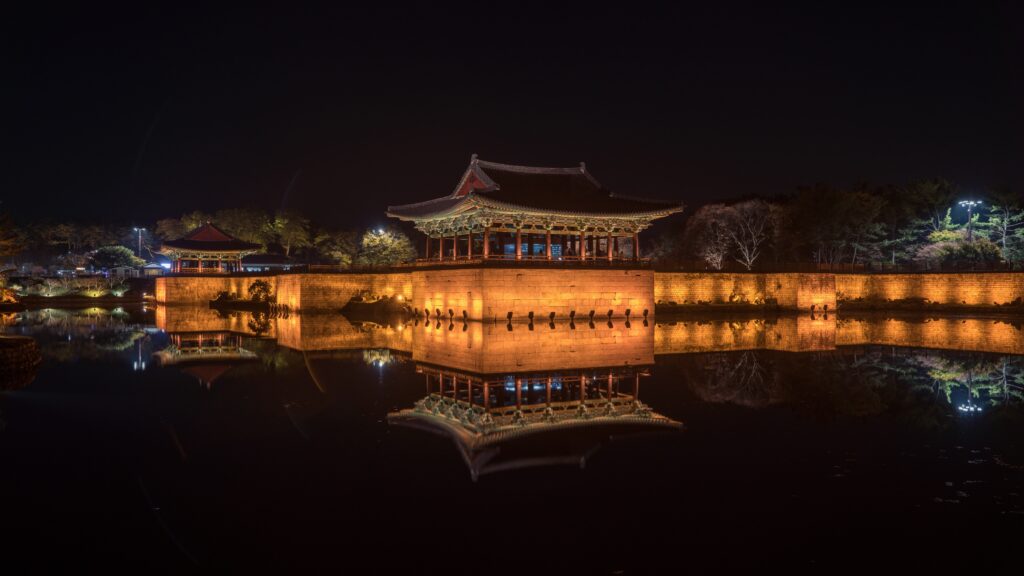
This post may contain affiliate links and I may earn a small commission when you click on the links at no additional cost to you. You can read my full privacy policy here.
When someone asks me where my favorite place in Korea is, I don’t hesitate to say Gyeongju. After 3 years of living in Seoul, I’ve traveled to every corner of the country and Gyeongju remains my favorite destination. It’s often referred to as a “museum without walls” and the entire city is UNESCO-designated because of its large number of historical sites and cultural art, including temples, tombs, and palaces. When you aren’t exploring its rich history and culture, you can eat, shop, and relax in traditional Korean hanok buildings. Whether you’re traveling for history, culture, or simply an escape from the city, Gyeongju is the perfect addition to your Korea trip.


Top things to do in Gyeongju: FAQs
Why should I visit Gyeongju?
Gyeongju was the capital city of the Silla Dynasty for 992 years. Today, Gyeongju remains known for its historical and architectural sites and rich heritage with four UNESCO World Heritage Sites and 31 National Treasures. For anyone interested in Korean history and culture, Gyeongju is packed with interesting and unique sites from the Silla period. Outside of its many historical and cultural sites, it offers modern attractions as well. From dining and shopping in traditional Korean hanok buildings to relaxing or biking by a scenic lake, there is something to do for every traveler.
When should I visit Gyeongju?
Korea experiences harsh summers and winters, and since most of Gyeongju’s main attractions are outside, it’s best to visit during spring and fall. This is when the weather is milder and you can catch spring flowers or fall foliage if you’re lucky. If you can time your visit to Gyeongju with cherry blossom season, you’re in for a treat, although it will be crowded.
The Gyeongju Cherry Blossom Festival, which includes gorgeous scenery, live music, fireworks, a beer festival, and the cherry blossom marathon, is one of the top things to do in Korea in spring. The beautiful fall foliage also makes Gyeongju one of the best things to do in fall in Korea.


How to get to Gyeongju?
Gyeongju is easily accessible from all over Korea. Your options for traveling to Gyeongju include:
- By train: Gyeongju is well-connected by train, and you can take a KTX (Korea Train Express) from major cities like Seoul and Busan. You can book KTX tickets here. They go on sale exactly a month in advance and often sell out, so make sure to be on top of it!
- By bus: Intercity buses operate from cities all over Korea to Gyeongju. The bus terminals in Gyeongju are easily accessible and centrally located, and bus tickets are cheaper than train tickets. You can book express bus tickets here and intercity bus tickets here.
- By car: For maximum flexibility, you can drive yourself to Gyeongju. Keep in mind that all foreign travelers must have an International Drivers Permit (IDP) to drive a car in Korea.
- By guided tour: If you’d rather sit back and enjoy a hassle-free journey, you can join a guided tour with a local tour guide. This is an especially worthwhile option if you are traveling to Gyeongju on a day trip because it allows you to see as much as possible in one day.
Book your day trip to Gyeongju from Busan, including a local guide and stops at major tourist sites, here.
How long to spend in Gyeongju?
Gyeongju is a perfect 2-day trip. This allows you enough time to cover both the historic area in downtown Gyeongju and the UNESCO World Heritage sites that are slightly farther out of town. All of these sites are extremely worthwhile, so it’s worth spending at least one night.
If you don’t have the time, it’s also possible to do a day trip. Gyeongju is the best day trip from Busan and one of the best day trips from Seoul, although farther. Keep reading for my 2-day itinerary; only do day 1 if you’re on a day trip.
How to book the best hotels in Gyeongju?
The best booking platform for finding and reserving great hotels in Korea is Agoda. It’s owned by the same company as Booking.com but is based in Asia, making it great for finding any hotels you need. If you’re a backpacker staying in hostels, then Hostelworld is consistently the best hostel booking platform worldwide, and Korea is no exception. Book your Gyeongju accommodation on Agoda today:
Don’t want to search for the best option, or just don’t have time? That’s what I’m here for! As a professional travel advisor, I’ve vetted or personally stayed at the suggested properties below.
Where to stay in Gyeongju?
The best place to stay is downtown Gyeongju, within walking distance of the historic area. You’ll be able to walk to most of the major historic sites, plus endless restaurants, cafes, and shopping on the main culture street. From here, you can walk to everything listed on my day 1 itinerary, and you can easily catch a bus to the day 2 sights on the outside of town. Better yet, you’ll be within walking distance of both the bus terminal and the train station.
4-star: GG Hotel
3-star: Hotel Palace
2-star: Mason Mini Hotel
Hostel: Han Jin Hostel
How to book the best activities and excursions in Gyeongju?
The best activity and excursion booking platforms for Korea are Klook and GetYourGuide. Both websites have thousands of trustworthy travel experiences with verified user reviews. I use Klook and GetYourGuide to book almost all my excursions in Asia.
Is Gyeongju good for solo female travelers?
Yes, Gyeongju is a safe and desirable place for solo female travelers. I solo traveled there and had a great time, with the incredible sights made even better by lovely locals and an ease of getting around. The downtown area is compact and doable completely on foot, making it the perfect place to stroll around on your own. If you decide to venture to the sights outside of downtown, there are reliable buses (although intervals can be long). Gyeongju is safe to walk around alone even at night, and offers many unique sights, aesthetic restaurants, calming cafes, and historic areas. Because of this, I highly recommend Gyeongju to any solo female traveler in Korea.

Top things to do in Gyeongju
1. Visit an ancient burial tomb at Daereungwon Tomb Complex
There are five ancient Silla tombs at Daereungwon Tomb Complex. The complex is peaceful and relaxing to walk around, with the tombs looking like rolling green hills. Make sure to stop at Cheonmachong Tomb and Jjoksaem Excavation Site, where you can see inside an ancient tomb and learn how they were excavated.


2. Explore the history of Korea’s former royal capital at the Gyeongju National Museum
Many of the artifacts excavated from the Daereungwon Tomb Complex are on display at the Gyeongju National Museum. There are countless historical and cultural artifacts from the Silla dynasty, including the popular Silla Art Gallery and Silla History Gallery.
3. Wander down Hwangnidan-gil culture street
Hwangnidan-gil is a culture street next to Daereungwon Tomb Complex with cafes, shops, and restaurants inside traditional Korean hanok buildings. Hwangnidan-gil is the main street, but allow yourself to get lost in all the side streets. The entire area is packed with modern establishments in traditional architecture. Ever wanted to eat pizza or drink Starbucks in a hanok? Now’s your chance!



4. See the oldest astronomical observatory in Asia, Cheomseongdae
Perhaps the most famous landmark of Gyeongju is Cheomseongdae, the oldest surviving astronomical observatory in Asia. In the Silla period, they used it to observe the stars to forecast the weather. The areas surrounding Cheomseongdae, such as Gyerim Forest and Wolseong, are worth wandering around during your visit. If you visit in the fall, you can see the famous pink grass here. In the spring and summer, the fields come alive with flowers.


Explore Korea like a local with expert guidance
Gyeongju’s ancient charm deserves more than a basic itinerary. I help travelers plan custom trips with the perfect mix of must-sees, hidden gems, and cultural experiences, plus hotel bookings and all the details taken care of. I lived in Korea for 3 years, so you can trust my insider tips to make your Gyeongju trip seamless and unforgettable.
Let’s start planning your perfect Gyeongju adventure today!
5. Watch the sunset at Woljeong Bridge
Woljeong Bridge is a wooden bridge that was built in the Silla period but burnt down during the Joseon Dynasty. Historians have since reconstructed the bridge, and it’s now the largest wooden bridge in Korea. It’s especially stunning at dusk when you can watch the sunset and see the bridge light up for the night.


6. Take a night stroll at Donggung Palace & Wolji Pond
Donggung Palace & Wolji Pond were part of the palace complex of ancient Silla, used as the crowned prince’s palace. When it gets dark, the palace lights up and reflects against Wolji Pond, making it especially worth visiting at nighttime.

7. Experience 8th-century Korean Buddhism at Bulguksa Temple
Located outside of downtown Gyeongju, Bulguksa is a UNESCO World Heritage Site and one of the most visited temples in Korea. Built in the Silla period, it’s considered a masterpiece of Buddhist art because of its stone terraces, bridges, and two pagodas. It’s home to seven National Treasures, the most of any temple in Korea.



8. See world-famous Buddhist art at Seokguram Grotto
Seokguram Grotto, another UNESCO World Heritage Site, sits on the top of Mount Toham above Bulguksa Temple. Its most famous attraction is the statue of the Buddha looking at the sea, housed in a granite grotto. Together with the sculptures on its surrounding walls, the statues are considered to be masterpieces of East Asian Buddhist art.
9. Take in views of Bomunho Lake from the delicious Cafe Aden
Located right outside of downtown Gyeongju, Bomunho Lake is a beautiful and calming lake surrounded by tourist resorts. There are walking and bike trails surrounding the lake, or you can sit back and take in the view with a delicious coffee and pastry at Cafe Aden.


Things to do in Gyeongju: 2-day itinerary
Day 1: Downtown Gyeongju Historic Area
Daereungwon Tomb Complex → Gyeongju National Museum → Hwangnidan-gil → Cheomseongdae → Woljeong Bridge → Donggung Palace & Wolji Pond
Your first day in Gyeongju can be done entirely on foot, seeing the gems of the Gyeongju Historic Area. Start your day by strolling around Daereungwon Tomb Complex, making sure to stop at Cheonmachong Tomb and Jjoksaem Excavation Site. Afterwards, walk over to the Gyeongju National Museum where you can see many of the excavated artifacts and more from the Silla period. Once you’ve worked up an appetite, head over to Hwangnidan-gil to find a restaurant set in a traditional Korean hanok building for lunch. After lunch, spend a few hours wandering the culture street and stopping at adorable shops and cafes. Then walk over to Cheomseongdae, making sure to spend some time exploring Gyerim Forest and Wolseong while you’re there. Finally, as the sun starts to set, spend dusk at Woljeong Bridge before heading to Donggung Palace & Wolji Pond once it’s dark.



Day 2: UNESCO World Heritage Sites outside of downtown
Bulguksa Temple → Seokguram Grotto → Bomunho Lake & Cafe Aden
Today, you’ll venture outside of downtown Gyeongju to see the UNESCO World Heritage Sites regarded for their Buddhist art. Hop on a bus to Bulguksa Temple and spend a couple of hours exploring the grounds before taking the shuttle bus or hiking up to Seokguram Grotto. If you want to catch a ride up the mountain, check at the tourist center for the shuttle bus times. Once you’re done at Seokguram Grotto, either catch the shuttle bus or hike down the mountain before transferring to a bus to Bomunho Lake. You can choose to walk or bike around the lake or head straight to Cafe Aden to enjoy delicious coffee and pastries while taking in the lake views.



Have I convinced you to include Gyeongju on your Korea trip itinerary yet? This culturally and historically rich city is a must-see for any traveler. From visiting its four UNESCO World Heritage Sites to dining and shopping in traditional Korean hanoks, Gyeongju offers its visitors a perfect mix of modernity and ancient treasures. You’ll quickly understand why it’s my favorite place in Korea, and it will undoubtedly turn into your own.
Keep reading:
- 2 week South Korea itinerary & travel guide from a local
- South Korea Solo Travel Guide: Safety, tips, & what to expect
- Best things to do in Jeonju, South Korea
- 15 BEST day trips from Seoul
- 10 best day trips from Busan
- South Korea packing list: A local’s guide to what to pack
- What to know before going to South Korea: 33 tips from a local
- 25 unmissable things to do in Korea in winter
- 31 unmissable things to do in spring in Korea
- 22 best things to do in summer in Korea
- Fall in Korea: The 26 best things to do
- Top 10 things to do in Andong, South Korea
- Vegetarian in Korea: The ultimate survival guide




Leave a Reply